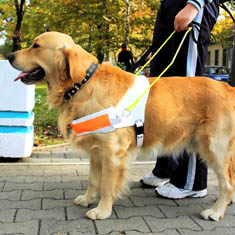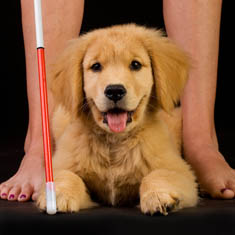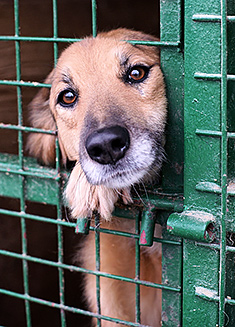Everything You Wanted to Know about Guide Dogs

Professional Organizations
There are a handful of training schools for Seeing Eye dogs in North America. The oldest is The Seeing Eye in Morristown, New Jersey. Others include:
• Guide Dogs of America in Sylmar, California
• Canadian Guide Dogs for the Blind in Manotick, Ontario
• Lions Foundation for Dog Guides in Oakville, Ontario
• Guide Dog Foundation for the Blind in Smithtown, NY
• Guide Dogs for the Blind in San Raphael, CA and Portland, OR
• Guiding Eyes for the Blind in Yorktown Heights, NY.
Each of these organizations breeds and trains their own dogs, using volunteer homes to raise them through their puppyhood. Trained dogs are then made available to clients throughout the United States and Canada.
Breeding Programs
The most commonly used breeds for guide dogs are Labrador Retrievers and Golden Retrievers or a cross of the two. Some schools also breed and train German Shepherds for use as guide dogs. Rarely, if an applicant for a dog has allergies to long-haired breeds, the school may find a Boxer at a local breeder and train the dog at the school for use by the allergic person.
While much genetic research has been done to find the “perfect” guide dog, the reality is that a great deal of the success of a dog has to do with the suitability of the match made with the human who will own the dog. Matching includes consideration of variations in size, strength, and energy level, as well as temperament, for both the human and the canine.
In many cases, names for the dogs may be selected by sponsors who donate money to one of the organizations in support of their programs. The cost to train one guide dog averages somewhere between $25,000 and $50,000, and most of these organizations are non-profits, so public donations are welcomed. At most of the schools, there is no cost passed on to the people who are matched with the dogs, and in some cases, the students’ travel and accommodations are paid for by the organization during training.
Puppyhood
Puppies are generally weaned from their mothers by eight weeks, and placed with foster families, who will keep them until they reach 12 - 18 months of age. The responsibilities of the foster homes include housebreaking, basic obedience training, and socializing the puppy to offices, shopping malls, and public transportation. At some schools, foster families are required to bring the puppy back to the school every month for puppy classes.
While veterinary care is generally provided by the organization, foster families usually pay for food and other day-to-day expenses associated with having a dog in the home.
Before graduating from foster care, the puppies are screened for temperament and physical soundness.
Formal training
Each guide dog training schools employs professional trainers who have undergone at least three years of apprenticeship at a certified school for guide dogs. Trainers must have the ability to work with both the dogs and the visually impaired humans who will eventually take the animals home.
Once the dog has completed his foster care basic training and has passed the screening tests, he or she returns to the school to begin formal training, which can take from four to eight months. The skills each dog must learn include finding and following a clear path, maneuvering around obstacles, and stopping when they reach a curb beside a road.
The dogs are also taught a concept known as “intelligent disobedience.” This means that the dog will not obey a command which would put his human into danger. For example, visually impaired people are taught to listen for traffic sounds to determine when to cross a street. When they feel it is safe, they will command the dog “forward”. If the dog knows that a car is coming, he or she will not leave the curb until it is safe, in spite of being given a command to move.
Among the various schools, the Lions Foundation of Canada Dog Guides is somewhat unique in that it trains other assistance dogs in addition to guide dogs. They train hearing ear dogs for the deaf, special skills dogs who retrieve objects and open doors for the physically disabled, seizure response dogs who warn of the impending onset of a seizure, autism assistance dogs who help kids on the Spectrum reduce stress so they can live more normal lives, and diabetic alert dogs who can detect drops in blood sugar and encourage their humans to eat.

Matching and Training with Clients
Prospective clients go through an extensive review process that reveals their specific needs, personality, physical strength and ability to handle a dog. People who are eventually accepted into these programs are motivated leaders who have enough strength and stamina to handle a large dog. They must also meet standards as to the level of their disability and their ability to be able to provide the dog with meaningful work throughout the course of his or her assistance career, which may be as long as eight to ten years.
After a dog completes his or her formal training, he or she is again assessed for temperament, skills, and suitability as an assistance dog. Next, the school matches each dog to a human handler. Great care is taken to match temperaments, size, lifestyle, and ability, to improve the probability of a successful match.
Most clients board at the school for the two to four weeks it takes to be trained to work with their new canine companions. The paired dogs and humans practice traveling through urban and rural areas, in shopping malls and other public places, and on public transportation. In addition, the new handlers are taught how to care for the dogs, including feeding, grooming, and medical care. Handlers are also made aware of laws concerning service dogs that allow their dogs to go anywhere the humans can go including into restaurants and other public establishments where dogs might otherwise be forbidden.
Adopting an Assistance Dogs
At several points during the socializing and training period, assistance dogs may be excluded from a program for failing to meet standards of temperament, confidence, or distractibility. Dogs with chronic health problems are also excluded.
Although the foster family is usually the first choice to adopt a dog who gets cut from the program, these dogs are occasionally made available to the general public. Most of these schools have very long waiting lists, however.
How should you interact with a guide dog?
The basic guideline for interacting with an assistance animal is to ask first. Most of the time, if the dog is identifiable as a service dog (e.g. in harness or wearing a vest), it means that the dog is working and should not be distracted. The Guide Dog Foundation for the Blind offers these etiquette tips:
- Don't touch, talk, feed or otherwise distract the dog while he is wearing his harness. Do allow the dog to concentrate and perform for the safety of his master.
- Don't treat the dog as a pet. Do give him the respect of a working dog.
- Don't give the dog commands. Do allow the master to do so.
- Don't try to take control in situations unfamiliar to the dog or master. Do assist the master upon his request.
- Don't walk on the dog's left side as he may become distracted or confused. Do walk on the owner's right side but several paces behind him.
- Don't attempt to grab or steer the person while the dog is guiding him or attempt to hold the dog's harness. Do ask if the owner needs your assistance and, if so, offer your left arm.
- Don't be over-protective or overbearing when the graduate first arrives home with the new dog. Do be thoughtful, patient, and try to inspire confidence in the master. In time, you will admire the expertise of the team.
- Don't expect too much too soon. Do remember that the dog is young and that complete harmony and confidence take patience, perseverance and time.
- Don't give the dog table scraps. Do respect the master's need to give the dog a balanced diet and to maintain its good habits.
- Don't allow children to tease or abuse the dog. Do allow it to rest undisturbed.
- Don't allow your pets to challenge or intimidate a guide dog. Do allow them to meet on neutral ground when all parties can be carefully supervised.
- Don't allow the dog on your furniture or in areas of the home mutually agreed upon by the family and master. Do ask the master to correct any errant behavior or trespassing.
- Don't let the dog out of the house unsupervised. Do understand its value to the master.
- Don't pat the dog on the head. Do stroke the dog on the shoulder area but only with its owner's approval.
Doggies Den: Latest Articles
 Homemade Thanksgiving Treats for Your Dog
Homemade Thanksgiving Treats for Your Dog
NUTRITION We all want to include our dogs in our holiday celebrations, but hopefully, you're aware that sharing table scraps with your dog isn't always the best idea.
 Keeping Your Dog Safe during the Summer Months
Keeping Your Dog Safe during the Summer Months
HEALTH Summer is coming on fast, so it’s time to plan how you will keep your dog safe and healthy through the lazy, carefree, warm days.
 Vaccination Time Again-Keeping Your Puppy Healthy
Vaccination Time Again-Keeping Your Puppy Healthy
DOG HEALTH So you have your new puppy picked out. There are quite a few shots, treatments and examinations that will keep the newest member of your family healthy.
 Canine Thanksgiving Feast
Canine Thanksgiving Feast
NUTRITION With the wide variety of food at Thanksgiving dinner, chances are you'll want to give your dog something special, too. If you're contemplating what to feed your dog for the holiday, here is a guide to a great Canine Thanksgiving Feast.
 Dog Walking Tips Every Owner Should Know
Dog Walking Tips Every Owner Should Know
DOG FUN Walking your dog is not only crucial to keeping him healthy and happy, it strengthens the bond between your canine friend and his caregiver. There are a lot of obstacles out there. Don’t forget these simple tips to keep your walk fun and safe in the outside world.
 The Benefits of Physiotherapy for your Dog
The Benefits of Physiotherapy for your Dog
HEALTH The same techniques that physiotherapists use to treat a variety of injuries and conditions in humans have been adapted to suit animals with great success. Family pets, show dogs, and working dogs can all benefit greatly from physiotherapy. Dogs whose activities involve a lot of agility are especially susceptible to the types of problems that physiotherapy can address.
 The Decision- Adding a Dog to Your Family
The Decision- Adding a Dog to Your Family
FIRST TIME OWNERSBringing a dog into your family is a decision where many people don’t realize it’s magnitude until after they have the dog. There are a number of things that you need to research before you decide to purchase a dog, and it starts right in your own home.
 Bringing Your Dog Into Your New Baby's Life
Bringing Your Dog Into Your New Baby's Life
HEALTH Many believe that a dog and a new baby cannot happily coexist, so therefore the dog has to go. This is not necessarily the case.  A new baby does not mean you have to abandon your dog.

Doggies Den:
Most Popular Articles

Dog Pregnancy Symptoms
HEALTHIf you suspect your dog might be pregnant, check out part one in this series on pregnant dogs, where we cover pregnant dog symptoms.

Dog Birth
HEALTHIn the third article of our dog pregnancy series, we look at the wonderful, but messy, process of bringing newborn puppies into the world.

Indoor Dog Potties
DOG PRODUCTSIt's been a long day at work. You were so busy, you didn't even take time to eat a sandwich, let alone run home to let your dog out. You're on your way home, knowing the poor dog is crossing his or her legs by now, when your car breaks down, delaying you even further. Can't somebody make this easier?

Your Dog’s Digestive System
PHYSIOLOGYEver wonder why your dog eats so fast? Or why he eats gross things? Or why he gets sick to his stomach? Or why his waste stinks so bad? Some of these things are normal, some are not.

Canine Respiratory System
BREATHINGThe basic function of your dog's respiratory system is to bring oxygen in to and remove carbon dioxide from the body. Knowing the symptoms of respiratory diseases can help you help your stay healthy.

Shelter Dog Adoption Tips for Success
ADOPTION Are you intimidated by the prospect of "rescuing" a dog from a shelter? One reason that you may be wary of adopting a dog from a shelter is not knowing how to choose. Adopting a dog from a shelter can be a rewarding process, if you're prepared to do a reasonable amount of research.

Canine Urinary Tract Infections
SYMPTOMS AND TREATMENTDoes your dog seem to be having trouble relieving his or her bladder? Learn how to recognize the signs of urinary tract infections and how to treat them before they spread.

What to do for Dog Diarrhea
SYMPTOMS AND REMEDIESIf you have dogs in your house for any length of time, you have likely experienced at least one bout of dog diarrhea. Beyond the pain in the tuckus involved in cleaning up the mess, you should know what causes diarrhea, and when it's important to see the vet.

What to do for a Dog Bite
DOG BEHAVIOR Getting bitten by a dog can be scary, and you may be tempted to run around in circles for a while, trying to figure out what to do. Here's our guide to help you manage the situation.

Top Ten Tips for Living with a Senior Dog
DOG HEALTH Bringing home a new puppy is so exciting, but it doesn’t take all that long for your exuberant puppy to grow into a senior dog who may have special needs. Here are the doggies.com top ten tips for taking care of your companion who has been with you through so much.
